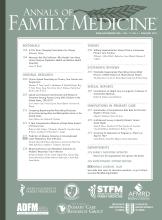Abstract
PURPOSE We wanted to describe the vocabulary and narrative context of primary care physicians’ inquiries about suicide.
METHODS One hundred fifty-two primary care physicians (53% to 61% of those approached) were randomly recruited from 4 sites in Northern California and Rochester, New York, to participate in a study assessing the effect of a patient’s request for antidepressant medication on a physician’s prescribing behavior. Standardized patients portraying 2 conditions (carpal tunnel syndrome and major depression, or back pain and adjustment disorder with depressed mood) and 3 antidepressant request types (brand-specific, general, or none) made 298 unannounced visits to these physicians between May 2003 and May 2004. Standardized patients were instructed to deny suicidality if the physician asked. We identified the subset of transcripts that contained a distinct suicide inquiry (n = 91) for inductive analysis and review. Our qualitative analysis focused on elucidating the narrative context in which inquiries are made, how physicians construct their inquiries, and how they respond to a patient’s denial of suicidality.
RESULTS Most suicide inquiries used clear terminology related to self-harm, suicide, or killing oneself. Three types of inquiry were identified: (1) straightforward (eg, “Are you feeling like hurting yourself?”); (2) supportive framing (eg, “Sometimes depression gets so bad that people feel that life is no longer worth living. Have you felt this way?”); and (3) no problem preferred (eg, “You’re not feeling suicidal, are you?”). Four inquiries were glaringly awkward, potentially inhibiting a patient’s disclosure. Most (79%) suicide inquiries were preceded by statements focusing on psychosocial concerns, and most (86%) physician responses to a standardized patient’s denial of ideation were followed up with relevant statements (eg, “I hope you would tell me if you did.”).
CONCLUSION Although most suicide inquiries by primary care physicians are sensitive, clear, and supportive, some language is used that may inhibit suicide disclosure. Some physician responses may unintentionally reinforce patients for remaining silent about their risk. This study will inform future research in the development of quality improvement interventions to support primary care physicians in making clear, appropriate, and sensitive inquires about suicide.
Footnotes
-
Conflicts of interest: none reported
-
Funding support: Original data collection was supported by a grant (R01 MH064683) from the National Institute of Mental Health. Data analysis and manuscript preparation for this manuscript was supported by National Institute of Mental Health grants T32MH73553 (Dr Vannoy), KL2RR025015 (Dr Vannoy), K24MH72756 (Dr Kravitz), K24MH072712 (Dr Duberstein), P50MH073511 (Dr Fancher).
-
Disclaimer: The design, conduct, data collection, analysis, and interpretation of the results of this study were performed independently of the funders. The funding agencies also played no role in review or approval of the manuscript.
A portion of the material in this article was presented as an oral presentation at the 2008 regional meeting of the California/Hawaii Society of General Internal Medicine Regional Meeting, San Francisco, California, and the 2008 National Society of General Internal Medicine Regional Meeting, Pittsburgh, Pennsylvania.
- Received for publication May 7, 2008.
- Revision received May 19, 2009.
- Accepted for publication June 12, 2009.
- © 2010 Annals of Family Medicine, Inc.







